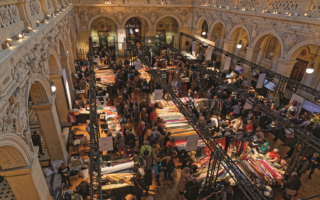Limoges: Charming china town
With its lofty spires, diverse museums and heavenly food, Heidi Fuller-Love discovers that Limoges is more than just the capital of fine china
Think of Limoges and you’re likely to conjure up an image of beautiful gilded porcelain with delicately painted decoration. But spend a few days exploring the tram-lined streets and cobbled alleys of this town on the banks of the River Vienne and you’ll soon realise that Limoges has a lot more to offer.
Founded on the river’s right bank as Augustoritum by the Romans around 10BC, Limoges mushroomed across the seven surrounding hills and now lies at the core of a grid of major roads linking France from north to south and east to west. In the third century AD, this wellconnected riverside town was converted to Christianity by Saint Martial, one of the seven bishops sent from Rome to Gaul by Pope Fabian to preach the Gospel. When Saint Martial died, the eponymous abbey built to house his relics became an important stop along the pilgrimage route to Santiago di Compostela. Today’s pilgrims still flock here to see the bishop’s tomb – housed in a spooky 10th-century crypt that was unearthed in the 1960s – beneath the abbey.
Impressionist painter Pierre-Auguste Renoir was born here in 1841 and began his artistic career painting flowery motifs on Limoges porcelain. French President Sadi Carnot also grew up in one of the city’s half-timbered houses and Richard Coeur de Lion was killed by a crossbow bolt just south of the city in 1199.
Surprisingly, this central city that is also the capital of the cattle-raising region of Limousin, is very compact – a non-polluting tramway zips you to all the main tourist sights in near silence, while kids love to hop on and off the tiny train that tours the town in summer.
Split into two main areas, the more peaceful Cit� quarter spills out from beneath the elegant skirts of the Bishop’s Palace, while the throbbing heart of this lively university town unfurls around the Cour du Temple, a 16th-century courtyard surrounded by shops, restaurants and terrace caf�s.
Built in 1210 to provide access to the Cit�, the impressive multiple-arched Pont Saint-�tienne is an ideal way to enter town. From the humpback of this eight-arch bridge, views of the city’s exuberantly ornate Cath�drale Saint�tienne, designed in 1272 by Jean Deschamps and hailed as one of France’s finest examples of Gothic architecture, are stunning.
Behind this massive edifice, which took 600 years to complete, stands the stylish 17th-century Bishop’s Palace, home to five of Renoir’s early canvases and the little-known Mus�e de l’�v�ch�. Still reeling from a robbery in 1981 that saw the loss of some of its best pieces, this fascinating museum boasts one of world’s largest collections of enamels dating from the 12th century – when Limoges was a major producer – until the present day. After the two-hour visit, enamel fans who want to get their hands on some of that elegant art can head for Boulevard Louis-Blanc, where Alan Grafeuil makes sumptuous enamels using those same age-old techniques.
If you’re feeling peckish, the Jardin de l’�v�ch�, with its fabulous views over the city, is perfect for picnics – and plenty of local bakeries (including Le Fourneau next to Monoprix on the Place de la R�publique) sell slabs of local speciality p�t� de pommes de terre, a potato and meat pie that makes a deliciously filling lunchtime snack.
Gazing out over the palace’s sweetscented park planted with medicinal and aromatic plants from five continents, you’ll find it hard to believe that the earth beneath your feet is criss-crossed by a 12-mile network of tunnels. Back in 1370, Limougeauds stored grain and wine, and even hid from the marauding armies of the Black Prince, in these subterranean passages; according to medieval chronicler, Jean Froissart, over 3,000 city dwellers were massacred during the brief siege by the man who never became king.
Still on the theme of slaughter, narrow cobbled streets that have hardly changed since Froissart’s time, lead from here to the Quartier de la Boucherie. Right up until the Revolution, 80 butchers wrought their trade in these half-timbered houses clustered around the tiny, cock-eyed, 13th-century Chapelle Saint-Aur�lien. Thankfully, the days when these streets ran red with blood are long gone, but Number 36 at the heart of this atmospheric quarter has been preserved as a fascinating museum-cum-medieval butcher shop, where you can see a 13th-century ice store, slaughter room and attics used for salting meats, without having to hold your nose.
The porcelain trail Next door on Place de la Motte, the 19thcentury covered market (open from 8am to 2pm) is a great place to buy scrumptious cheeses and saucissons, as well as fish, fruit and vegetables – and you can find everything from flowers and fashionable rags to perfume, shoes and chocolate in the surrounding pedestrianised streets.
And even if Limoges has more to offer than just’ china, you won’t be able to get away from the fabulous frail stuff that’s been made here ever since kaolin was discovered just down the road in Saint-Yrieix-la-Perche in 1771.
Wander the streets and you’ll find plenty of buildings, including Les Halles and the nearby Pavillion du Verdurier, that are decorated with gleaming Limoges ceramics, but if you want a closer look at the really precious stuff, then make a beeline for the Mus�e National Adrien Dubouch�.
Housed in a building that was once the city’s lunatic asylum, this high-ceilinged edifice is stacked with one of Europe’s largest ceramics collections, spanning two centuries of manufacture. Once you are familiar with the history of porcelain, take a factory tour of the legendary Bernardaud workshops and see how the porcelain is made today. If you want to invest in porcelain Bernardaud, and plenty of other shops along the Avenue Albert Thomas, sells goodies ranging from decorative tea sets and dinner services, to ornate candleholders and gilded ashtrays. Alternatively, try the very high-end Le Pavillon de la Porcelaine, Haviland’s shop on Avenue Pr�sident Kennedy. If you’re on a tight budget, your best bet is Michel Morel’s boutique on Boulevard Louis- Blanc, which stocks end-of-line samples, or discount stores near Place des Jacobins and Rue de la Boucherie.
With bags full of ceramic goodies, finish your day with a drink at the Brasserie Artisanale Saint Martial, a small brewery serving local beers that have been made in the region for centuries. Sit out on the terrace of this charming hostelry in the city’s buzzing centre and you’ll surely agree that, even though that white stuff is pretty wonderful, Limoges has a lot more to offer than simply fabulous china.
FRANCOFILE
WHERE TO STAY Luk Hotel 29 Place Jourdan Tel: (Fr) 5 55 33 44 00 www.lukhotel-limoges.com With breathtaking views and stainedglass designed by the Limoges artist Francis Chigot. Rooms from €44.60.
WHERE TO EAT Chez Alphonse 5 Place de la Motte Tel: (Fr) 5 55 34 34 14 Rustic dishes served on Limoges porcelain. Menus from €15.
Le Pont Saint-�tienne 8 Place de Compostelle Tel: (Fr) 5 55 30 52 54 www.lepontsaintetienne.fr Seabass risotto is one of the specialities of this charming restaurant overlooking the Saint-�tienne bridge. Prices from €20.
PLACES OF INTEREST Aquarium du Limousin 2 Boulevard Gambetta Tel: (Fr) 5 55 33 42 11 The renovated aquarium is set in subterranean reservoirs built by Napol�on III.
Mus�e de la R�sistance et de la D�portation 3 rue de la R�gle Tel: (Fr) 5 55 45 63 40 Created by members of the French Resistance to commemorate Haute- Vienne’s vital role during World War II.
ADDITIONAL INFORMATION Office de Tourisme 12 Boulevard de Fleurus Tel: (Fr) 5 55 34 46 87 www.tourismelimoges.com
Share to: Facebook Twitter LinkedIn Email


